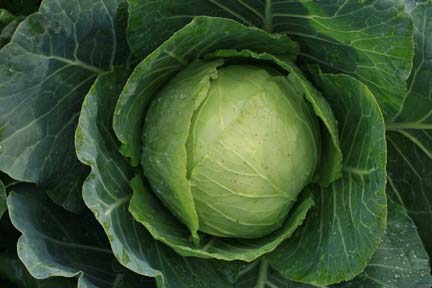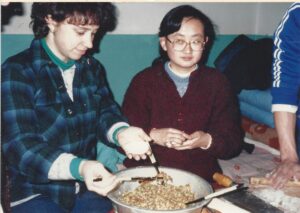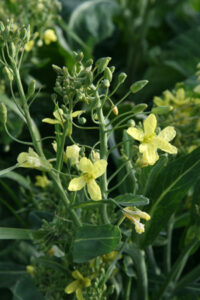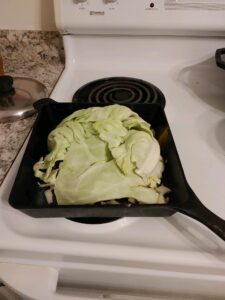Cabbage Family Reunion

The time has come,’ the Walrus said,
To talk of many things:
Of shoes — and ships — and sealing-wax —
Of cabbages — and….
~ Lewis Carroll, The Walrus and The Carpenter
The warm temperatures notwithstanding, it’s still winter so I’m going to step out on some thin ice and tell an ethnic joke at the expense of the Polish people. But before I do I’d like to share a small personal triumph. If you’re going to have kids, it’s probably a bad idea to count on having your efforts as a parent validated too soon, but I’m feeling good today. I’m a vegetable farmer and I enjoy cooking so of course I wanted my children to eat veggies. When he was young my son, Graydon, went through a phase where he’d only gladly eat “white food,” and by that I mean white rice, white cheese, and white bread. He’s 25 now and that time is thankfully long past. He grew up to discover a passionate interest in all things Asian, and that included getting a degree in Mandarin, and then he lived in Taiwan for a while. While in Taiwan he began teaching himself basic Chinese cooking techniques, and now that he’s back here he’s only amplified his interest. Not infrequently, he’ll text me pictures of what he’s cooking and I enjoy seeing how far he’s taken his interest. The Chinese have a way with cabbage, for sure, and it makes me feel good to see how Graydon’s childish abhorrence of vegetables is a distant memory.

Julia preparing dumplings in Beijing, China, 1987.
Graydon’s mother, Julia, lived in mainland China for a while when she was just out of college too, and she used to tell me that you could tell winter was coming when the trucks would roll into the cities loaded with cabbages. The people would buy loads and loads of cabbages and stack them up outside their homes. The weather was so cold that the whole world was like a refrigerator, so the cabbage would keep pretty well outside. Every day the people could bring a head or two inside, peel off a yellow leaf or two, and commence to make a meal. As a mother and a passionate cook and a confirmed Sinophile, Julia would love to see these texted photos of Chinese dishes that I receive rolling in from our son, but she passed away 6 years ago. In my experience grief is like a well-mannered dog that never leaves your side and remains quiet most of the time, usually choosing to put it’s nose in your hand and beg for attention up during moments of joy. I feel happy our son is cooking vegetables and enjoying Chinese food, and I feel sad that Julia is not here to share the moment. But that’s life, and grief is a part of life like a shadow that makes colors stand out more, or like a salt that deepens other flavors. But enough about other things; let’s talk cabbage.

Cabbage flower
Of course the cabbage that is most common in China is what we’d call Napa Cabbage here. Napa is a Brassica- Brassica rapa, related to the round Brassica oleracea cabbage that is most common in the west, but not closely. All Brassicas have tiny round seeds, paired valentine-shaped cotyledons when they germinate, and show off characteristic 4 petaled flowers when they reach sexual maturity, but beyond that they vary widely in form. A lot of the Brassicas grow well in cool weather, and the family really comes into its own in the kitchen during the winter. We’ve got a number of different Brassicas planted for you. This week it’s a regular cabbage family reunion in your harvest box; cabbage, broccoli and kale, for sure, and maybe turnips by week’s end if the little roots swell up fast enough. Like most garden plants, Brassicas grow easily enough if you give them what they want. These cabbages of ours grew easily enough, but we did make a mistake that I’d like to point out.
Cabbages are so important economically all over the world that plant scientists have worked to develop varieties for every season and growing region. These cabbages began to form heads just like they’re supposed too, but they didn’t get heavy. I suspect we erred and planted a variety in the fall that should have been planted in spring. All cabbages are fairly cold tolerant, but they behave differently under different light conditions. Some varieties perform best when the days are getting longer, as in the spring. Other varieties develop better when the days are getting shorter, as in the fall. Seeing that these cabbages were getting ready to bolt without getting heavy made me think we’d better pick them now. They taste good, but they’re light for their size. In the future we should probably plant this type in the spring so that it can grow super fast under the conditions of increasing day length; that way we’ll get the weight we want before the plants want to go to flower. These cabbages must be watching their mustard cousins blow up into a blaze of yellow flowers and they want to follow them. Which brings me back to my son, Graydon.

Salmon wrapped in Polish foil
Many, but not all Chinese Brassicas are members of the mustard side of the family; think turnips, gai-lan, the various choy types, mizuna, or the many mustards and radishes the Chinese favor. Graydon often cooks Chinese food, so I was surprised when he sent me a picture that I didn’t recognize as anything Chinese. I asked him what it was. “Salmon wrapped in ‘Polish foil,’” he responded. I still didn’t understand the joke, so he amplified. He’d gotten ready to make a baked salmon dish with a miso glaze and the recipe called for aluminum foil, but he didn’t have any, so he improvised and used green cabbage leaves. He’d been working with someone of Polish ancestry who’d turned him onto stuffed cabbage recipes and joked that cabbage leaves are “Polish foil.” And he told me something else that I never knew but that is apparently common knowledge among informed cooks all over the world from Warsaw to Beijing; cabbage is high in glutamates, those natural amino acids that lend “umami” to food- think monosodium glutamate, but natural. My days of schooling the kid on food are long over, and it’s my turn to learn.
Meanwhile, back on the ranch we are getting potatoes ready to plant, we’re transplanting more kohlrabi and lettuces, sowing trays of peppers, and watching the tomato seedlings get bigger.
© 2021 Essay and Photos by Andy Griffin.


